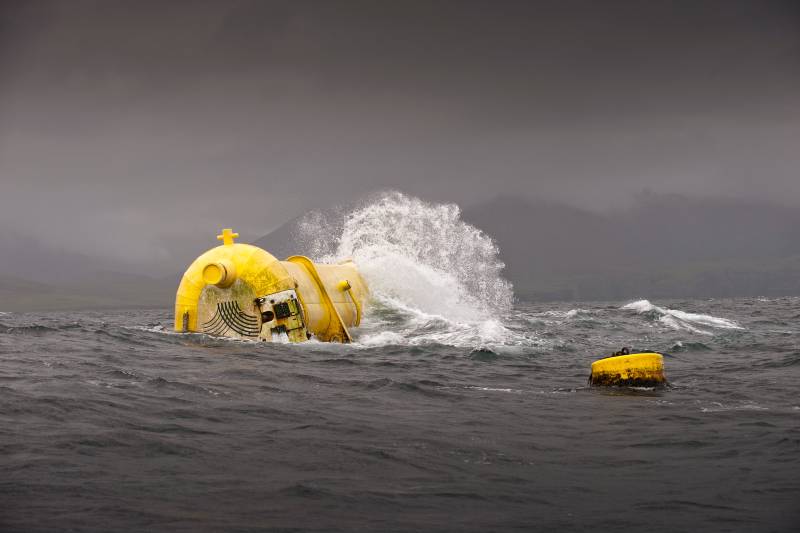Wave Energy Research at Queen’s University Belfast
Today, wave energy research at QUB continues in the fields of numerical modelling, physical testing and prototype development.
The ELoWEC project focussed on developing an understanding of extreme loads experienced by wave energy converters operating in very large sea states. The project used a combination of numerical modelling and physical wave tank testing to identify and characterise the previously unknown extreme loading mechanisms experienced by Oscillating Wave Surge Converters and provided recommendations on device design solutions which could be used to significantly reduce the magnitude of extreme loads experienced. The physical testing work required the development of new and complex experimental and analysis techniques which permitted automated characterisation of the loading mechanisms involved.
Work has also been ongoing to develop new methods of numerical modelling for Wave Energy Converters. The Spectral Domain Modelling method developed by Dr Matt Folley permits the accurate modelling of non-linear wave energy systems in the frequency domain using an approach based on statistical linearization. The result is that non-linear systems, which typically require modelling in the time-domain, can now be modelled in the frequency domain, meaning that results of comparable accuracy can now be obtained with much less computational demand. This vastly increases the use case of frequency domain models, meaning that optimization studies and iterative investigations can perhaps be conducted in seconds as opposed to days, weeks or moths without loss of accuracy.
Most recently, QUB pioneered the LiftWEC project, seeking to develop a new class of wave energy converter based on the use of hydrodynamic lift forces. More detail on this project can be found here: https://liftwec.com/
QUB personnel involved
Professor Trevor Whittaker (Emeritus Professor)
Dr Carwyn Frost
Dr Louise Kregting
Dr Wesley Flannery
Dr Matt Folley
Dr Pal Schmitt
Dr Paul Lamont-Kane
During its time spent in wave energy research, QUB has raised over £20,000,000 in academic research funding. QUB has supported the rise of wave energy towards its position as a mainstream field of academic research. QUB has installed 7 full scale, prototype devices either directly or through a number of spin-out companies, including LIMPET, the world’s first grid connected Wave Energy Converter. QUB developed both Wavegen and Aquamarine Power Ltd., which have been two of the most successful Wave Energy Developers to date worldwide raising a combined total of over £100,000,000 for the development of their respective technologies. The Marine Research Group has saw over 40 successful PhD completions and it is estimated that through the Marine Research Group and associated spin-out companies, Professor Trevor Whittaker has been responsible for approximately 500 years of combined personnel employment.
Research outputs from QUB have directly impacted the wave energy sector in countless ways including influence on experimental methodology, numerical modelling techniques and real-world device design. The Oscillating Wave Surge Converter which is widely considered to be one of the most promising wave energy technology was incepted, developed and matured by QUB before being widely adopted by many hundreds of other researchers. The work on extreme and fatigue loading of devices has directly impacted the design of a number of real-world systems and QUB continues to work with commercial partners to realise commercial viability of the Wave Energy industry.
LiftWEC
The LiftWEC project has received funding from the European Union’s Horizon 2020 Research and Innovation programme under Grant Agreement No 851885. Total grant value: € 3,404,730.
https://cordis.europa.eu/project/id/851885
MARINET 2
The MARINET 2 programme has received funding from the European Union’s Horizon 2020 Research and Innovation programme under grant agreement No 731084. Total grant value: €10,592,285.
https://cordis.europa.eu/project/id/731084
The Bryden Centre
The Bryden Centre has received funding from 2014 - 2020 INTERREG V-A United Kingdom-Ireland (Ireland-Northern Ireland-Scotland). Total grant value: €9,752,679.
https://keep.eu/projects/20743/The-Bryden-Centre-for-Advan-EN/
Key research papers:
Henry, A, Folley, M and Whittaker, T [2018]. A Conceptual Model of the Hydrodynamics of an Oscillating Wave Surge Converter. Renewable Energy, 118, 965-972
Folley, M. [2016] Editor, Numerical modelling of wave energy converters, Elsevier, London, UK
Schmitt, P. and Elsaesser, B. [2015]. On the use of OpenFOAM to model Oscillating wave surge converters. Ocean Engineering, 108, 98-104.
Whittaker, T. and Folley, M. [2012]. Nearshore Oscillating Wave Surge Converters and the Development of Oyster. Philosophical Transactions of the Royal Society A 370: 345-364
Folley, M. and Whittaker, T. [2010]. Spectral modelling of wave energy converters. Coastal Engineering, 57, 892-897
tbc
The Marine Research Group at QUB focuses on research which responds to the call for action on the following Sustainable Development Goals (https://sdgs.un.org/goals):
· # 7 Affordable and clean energy
· # 9 Industry, innovation and infrastructure
· # 11 Sustainable cities and communities
· # 13 Climate action
· # 14 Life below water
-
Marine Research Group at Queen's University Belfast
RELATED PEOPLE
- Trevor Whittaker https://pure.qub.ac.uk/en/persons/trevor-whittaker
- Louise Kregting https://pure.qub.ac.uk/en/persons/louise-kregting
- Carwyn Frost https://pure.qub.ac.uk/en/persons/carwyn-frost
- Wesley Flannery https://pure.qub.ac.uk/en/persons/wesley-flannery
- Matthew Folley
- Pal Schmitt https://pure.qub.ac.uk/en/persons/pal-schmitt
- Paul Lamont Kane https://pure.qub.ac.uk/en/persons/paul-lamont-kane

